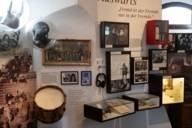
For the “I've never been to...“-series, our authors explore places in Munich that they have never visited before – although they have lived in the city for years or even for a lifetime. This time, Anika Landsteiner embarks on her first visit to the Valentin-Karlstadt-Musäum.
“Of course, I know Karl Valentin,” I say confidently. “The comedian, right?”, I quickly add. In fact, I know very little about the life and work of this Munich legend. That's partly, because I have never been to the Valentin-Karlstadt-Musäum, which is dedicated to him and his partner Liesl Karlstadt. The museum was founded in 1959 and initially focused exclusively on Valentin, until in 2001, the Karlstadt Cabinet was added on the second floor.
I step into the small entrance area and climb the narrow staircase to the first floor. The museum, nestled within the stone towers of the Isartor (gate), feels like a step back in time. In a charming, quaint way that appeals to me.
The permanent exhibition on the first floor is a tribute to Valentin's life and work. I quickly lose track in this lovingly curated hotchpotch of personal items, stage props, and quirky artefacts. Among them is my favourite: The winter toothpick covered in fake fur. I hear another visitor loudly wondering: “Where does it all begin here?”. I can't help but smile because this slight sense of disorientation seems to fit Valentin's character: Someone who has explored and mastered so many skills – acting, comedy, film, verbal acrobatics, and more – must have felt overburdened at times.
From the personal accounts, I learn that Valentin grew up in a privileged environment but not without trauma: His sister and two brothers died in infancy, he was the only one to survive. His mother, suffering because of these losses, projected her fears onto him. The gaunt boy grew into a nervous hypochondriac and control freak. He was often found in various doctors' waiting rooms, asking: “Do you think this is something one can catch easily?“ When Valentin put his fears into words, he liked to infuse his typical humour. Speaking of humour! One loop further on, the exhibit “Melted snow sculpture“ makes me laugh: a bowl of water.
One more loop, and the “lying stand-up collar“ appears – a white, probably starched collar that, well, lies flat. You can go round and round this little tower as often as you wish and always end up in a surprising spot. Perhaps it's because of the childlike, no-frills core of Valentin's humour that he is still hailed as a universal genius who influenced artists like Bertolt Brecht, Loriot, as well as the Irish writer Samuel Beckett.
Together, as a couple with Liesl Karlstadt, the playwright achieved the breakthrough on stage. Their sketches and later short films are bizarre and filled with slapstick, largely due to Valentin's long, skinny body, which he staged so skilfully. You can enjoy this chaotic confusion in the mini cinema, which screens a selection of their films in full length. Before taking a seat myself, I enjoy the other visitors sitting there, chuckling at the duo.
A key element of the sketches is the ambiguity of language. Valentin often portrayed himself as the stubborn character, who worked himself up, while Karlstadt assumed the rational role that calmed him down. It seems that there was a parallel in their private life: the two became lovers, despite Valentin being a married family man. This situation was extremely stressful for Karlstadt, also because she constantly supported Valentin, the nervous wreck and grump.
In October 1934, Valentin opened his “Panoptikum,“ a blend of waxwork curiosities and a chamber of horrors. The realisation of this project required a substantial amount of money, leading Liesl Karlstadt to take out a private loan to support it. Unfortunately, visitors were shocked and showed little interest in the exhibits, so the project failed. Karlstadt had a similar experience. After the “Panoptikum“ closed because it was a financial disaster, Karlstadt fell into a deep crisis and attempted to take her own life.
Valentin's work was increasingly forgotten during the Second World War. This sad development also offers a poignant insight into the cultural side of those times: Museums and institutions had to close or were destroyed, and performances were cancelled. In 1941, Valentin was forced to move to Planegg as his Munich residence had been destroyed. The move caused him so much distress that he wrote a desperate letter to the mayor of Munich in 1945, requesting new accommodation in the city. The letter, which is displayed in the museum, concludes with the tragicomic line: “I am now 63 years old, but I am still as sprightly as if I were only 62.“
After this detailed insight into Valentin's life, I take a detour to Karlstadt's exhibition rooms to find out what happened after her crisis. Following a two-year hiatus and Valentin's passing in 1948, she performed at prestigious theatres, such as the Münchner Kammerspiele and the Residenztheater. She even starred in the first German television advert for Persil washing powder, which was broadcast in 1956. In a letter, Valentin once wrote to her, “You are only the genuine Lisl Karlstadt when you are by my side,” – an insolence that leaves me speechless. Karlstadt's successes show that she was indeed able to forge a career independent of him, and perhaps even enjoyed greater freedom without him.
At the very top of the south tower is a quaint, traditional café. Various quirky decorative elements blend Valentin's love for the bizarre with the cosiness of the space. The café opens at 11:01 in the morning, in line with his sense of humour, and offers Weisswurst (traditional veal sausages), cake and coffee. I opt for hot chocolate with cream and watch the little bat dummy above the entrance door, which swings into motion whenever the door opens. It startles me every time. Valentin would have loved that.